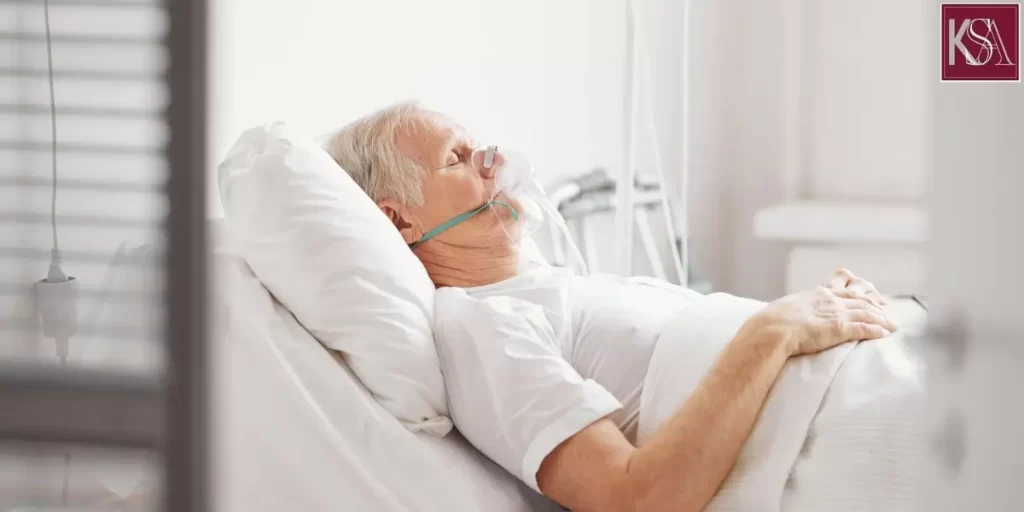san bernardino
Bed Sore Lawyers
Bed Sore Attorneys in the Inland Empire
In hospitals, extended care facilities and nursing homes, patients must be attended to regularly. One problem that can arise if patients are left laying in beds or sitting in wheelchairs too long without being moved is bed sores, also known as decubitus ulcers. Bed sores can be extremely painful. Left unchecked, they can become infected and lead to serious complications. Medical facilities may be held accountable for bed sore injuries. The unfortunate truth is that bed sores are preventable wounds, and the pain and suffering they cause are completely unnecessary. There is absolutely no justification for employees of care facilities to allow them to become an issue, which is why their occurrence is considered to be neglect. Medicare guidelines indicate that these ulcers are a “never event,” which means that they should never happen.
At Kampf, Schiavone & Associates, we hold doctors, nurses, extended care facilities and nursing homes accountable for serious injuries. Our lawyers have extensive combined experience handling bed sore cases for people in San Bernardino and throughout California’s Inland Empire, so you can be confident we can help you.

Why Do Bedsores Form in Care Facilities?
Bedsores typically occur due to improper hygiene and lack of movement, especially in patients who are confined primarily to their beds. Restricted blood flow in certain parts of the body due to these factors is the cause of the pressure sores. They typically occur in the head, back, buttocks, and heels. Although some patients have poor circulation due to health-related issues, that does not excuse the care facility from taking preventive measures that would protect the patient from bed sores. Medical malpractice occurs when a care facility fails to prevent or properly treat bedsores, leading to further harm and complications.
When a patient is at risk of developing bed sores because they cannot move on their own, the nursing staff at the hospital or nursing home must offload pressure from the patient by repositioning them every two hours to prevent bed sores. Nursing home neglect results when the facility staff fails to follow this procedure. There are federal laws in place that are meant to protect patients from this type of neglect. Despite the fact that care facilities are aware of the risks and trained in proper procedures to prevent bed sores, they are still a common occurrence in long-term care facilities. This is sometimes a result of nurses who are overworked due to a shortage of care staff. At times, conditions are so poor that patients are left in their own urine, which can lead to even more serious infections. The skin that is affected by the bed sores can be damaged permanently in such conditions.
The hospital or care facility is responsible for seeing that patients are moved at their scheduled times every two hours and for checking to make sure that the patient’s bedding and clothing are dry. These routine processes for ensuring the safety of patients should be in place if the facility is adequately fulfilling the job of hiring and training its staff. In addition to the standard of care of ensuring that patients are turned every two hours when they are at risk for bed sores, the nursing staff should also use air mattresses, special pillows, cushions, and other items to reduce pressure on the skin of patients who are considered to be non-mobile.
Who Is at the Greatest Risk of Suffering From Bed Sores?
- Smoking. Since smoking restricts blood flow, just as a circulatory disease would, it inhibits circulation to areas that may be affected by bed sores.
- Peripheral Arterial Disease (PAD), vascular disease, and diabetes. These types of diseases accelerate the development of wounds and restrict blood flow, which can make existing pressure wounds more difficult to treat. Although a patient may suffer from this disease, it does not excuse care facilities for the development of bed sores.
- Malnutrition. If an individual is not properly nourished, the deficiencies in nutrients may exacerbate the chances of developing bed sores and make them more difficult to treat.
- Incontinence. If a patient is incontinent, the moisture associated with this condition may increase the chances of developing pressure sores. The existence of urine and feces in the wound area also increases the chances that the bed sore will become infected.
- Lack of pain receptors. Some elderly patients suffer from nerve disorders that prevent them from experiencing discomfort or pain that indicates they need to change their position in the bed.
- General aging. As individuals age, especially as they become elderly, their skin gets thinner and is more prone to developing bed sores.
What You Should Know About Bed Sores Acquired in a San Bernardino Care Facility
- When patients develop bed sores, the most common factor that results in death is infection. Bed sores can lead to a bone infection called osteomyelitis and the blood infection known as sepsis.
- Most patients who suffer from bed sores die as a result of the wound within a year’s time.
- The most effective way to avoid the devastating effects of bed sores is to prevent them from developing in the first place.
- Since bed sores are considered to be preventable when a facility provides appropriate care, most insurers refuse to reimburse a nursing home or hospital for would care on pressure sores that develop in the facility.
- Hospitals and nursing homes must, by law, track new and existing areas where the skin has broken down.
Statistics Regarding Bed Sores in Care Facilities
The Centers for Disease Control reports that more than 10% of nursing home patients suffer from bed sores. Out of those patients, half of them developed Stage 3 or 4 pressure sores – the most severe, painful, and deadly wounds. These preventable wounds are considered to be an effect of neglect because there is no reason for them to ever occur.
In most cases, bed sore victims are over the age of 60 and are unable to move much on their own, if at all. These patients are unable to reposition themselves when they are confined to a bed, which is why the care staff must move them every two hours. Nursing homes are known to frequently be understaffed. If there are not enough nurses to properly care for the patients at the facility, many of these patients do not get repositioned nearly as frequently as they should be. In the most severe cases, the patients are left unattended in their beds, lying in their own feces and urine, and developing bed sore infections that may kill them. In addition to not being moved often enough, malnutrition and dehydration are other forms of neglect in care facilities that can lead to bed sores.
It is vital for family members and loved ones to be stewards of the care facility patients in their lives since nursing homes today are experiencing budget cuts that result in understaffing. Often, nurses in these facilities are also unqualified to perform the job or have not been trained properly, leading to unacceptable, inadequate care. The National Library of Medicine National Institutes of Health conducted studies showing that hospital patients who are nursing home residents have five times the likelihood of experiencing bed sores than other patients.
Be Aware of the Infections That Are Common Among Patients Who Suffer Bed Sores
- MRSA
- Pseudomonas aeruginosa
- Proteus mirabilis
- Staphylococcus aureus
- Septic arthritis
- Cellulitis
- E. Coli
- Sepsis
- Osteomyelitis
What Can You Expect to Feel When You Are Suffering From Bed Sores
Know Your Legal Rights if You or a Loved One Have Suffered Bed Sores
It is vital to take immediate action if you or a family member have developed bed sores while in a nursing home or care facility. It is essential to show these sores to a head nurse or doctor as soon as you notice them. Additional steps you should take include taking photographs of the pressure sores and making a list of all doctors and nurses you have spoken to about the wound. These details will help your San Bernardino bedsores attorneys to establish your case for neglect.
A bedsore neglect lawsuit can be filed to hold medical facilities responsible for these painful, preventable wounds. The law allows you to recover compensation for your pain and suffering through the civil justice system in these cases. A knowledgeable attorney will be able to help you file this claim against the hospital or nursing home where you or your loved one developed the decubitus ulcers.
The Reason It Is Crucial to Take Photographs of Your Bed Sores
There is no denying that pictures of bed sores are revolting and often shock those who see them. The photographs commonly show an area of the skin that is affected by a gaping hole. Many times, this wound is located on the sacrum or the backside of the heels. Fatally infected wounds are often some of the most awful to see in pictures. Individuals who view such photos can begin to imagine the pain that the patient is suffering.
The photographs that patients gather when they are afflicted with bed sores help attorneys to establish a legal case, as the wounds are classified by severity, ranging from Stage 1 to Stage 4. The first stage of bed sore infection typically looks like a small red spot. As the situation progresses, the photos are able to document the progression from this stage to the horribly cavernous wounds that are often associated with Stage 4 bed sores. These devastating wounds are often infected the whole way to the bone (osteomyelitis). If you have not documented the progress of the bed sores, your San Bernardino bed sores attorneys may be able to obtain medical records that help to ascertain the severity of your case.
As you can see, it is vital to document pressure sore wounds as diligently as possible to act as evidence in your bed sore neglect case. Attorneys are able to use these photographs to prove the existence of bed sores, as well as the date that the pressure wounds first became apparent. If your neglect claim goes to court, your lawyer will be able to use these photos against the care facility guilty of neglect.
One important factor to keep in mind is that you cannot rely on the hospital or nursing home to document the bed sore with photos or provide you with such documentation. You may witness the nursing staff at the facility taking photographs of the bed sores, but this is no guarantee that the pictures will go into the patient’s medical records. For this reason, it is essential to document the wound with your own photographs so that you have the evidence you need if you file legal action against the facility for abuse.
Bed Sores May Be One Symptom Of Greater Negligence
It is important that an attorney review all of the facts involved in a medical malpractice or personal injury case in California. When we investigate bed sore cases, we may find that there is greater negligence taking place than a patient not being moved from a bed or a wheelchair regularly. We may discover that a patient is not being fed properly and is at risk of malnutrition and dehydration. We may learn that the patient is not being provided his or her prescribed medications. There may also be emotional abuse taking place, with the patient being left isolated and alone for long periods of time. Whatever the case may be, we will take action.
Consultation
To arrange your initial consultation about a San Bernardino bed sore claim, call our 24-hour toll-free number — 909-885-1522. You can also get in touch with us via email. Home and hospital room visits are available to those whose injuries prevent travel. Se habla español.

